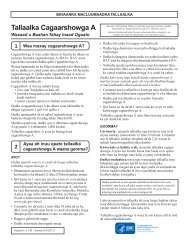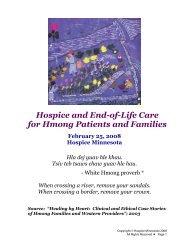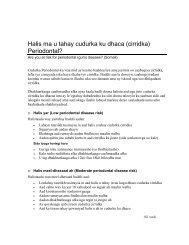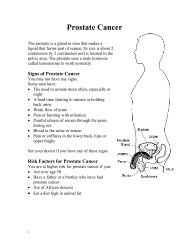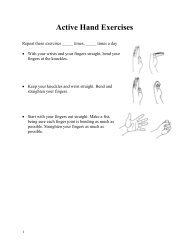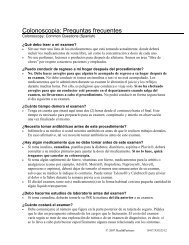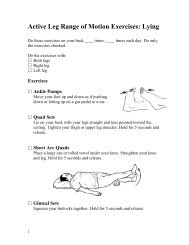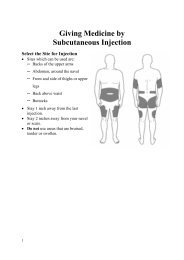The TB Skin Test (Mantoux) â - Minnesota Dept. of ... - the Exchange
The TB Skin Test (Mantoux) â - Minnesota Dept. of ... - the Exchange
The TB Skin Test (Mantoux) â - Minnesota Dept. of ... - the Exchange
You also want an ePaper? Increase the reach of your titles
YUMPU automatically turns print PDFs into web optimized ePapers that Google loves.
<strong>Minnesota</strong> Department <strong>of</strong> Health<br />
<strong>The</strong> <strong>TB</strong> <strong>Skin</strong> <strong>Test</strong> (<strong>Mantoux</strong>)<br />
<strong>The</strong> <strong>TB</strong> <strong>Skin</strong> <strong>Test</strong> (<strong>Mantoux</strong>) English<br />
<strong>The</strong> tuberculosis (<strong>TB</strong>) skin test, sometimes<br />
called a “<strong>Mantoux</strong>,” is a simple, harmless way<br />
to find out if you have latent <strong>TB</strong> infection.<br />
What is latent <strong>TB</strong> infection<br />
<strong>The</strong>re are two phases <strong>of</strong> <strong>TB</strong>. Both phases can be<br />
treated with medicine. When <strong>TB</strong> germs first<br />
enter your body, <strong>the</strong>y cause latent <strong>TB</strong> infection.<br />
Without treatment, latent <strong>TB</strong> infection can<br />
become active <strong>TB</strong> disease. Anyone can get <strong>TB</strong><br />
because it spreads from one person to ano<strong>the</strong>r<br />
through <strong>the</strong> air.<br />
Phase 1 –<br />
Latent <strong>TB</strong> Infection<br />
<strong>TB</strong> germs are “asleep”<br />
in your body. This<br />
phase can last for a<br />
very long time – even<br />
many years.<br />
You don’t look or feel<br />
sick. Your chest x-ray<br />
is usually normal.<br />
You can’t spread <strong>TB</strong> to<br />
o<strong>the</strong>r people.<br />
Usually treated by<br />
taking one medicine for<br />
9 months.<br />
Phase 2 –<br />
Active <strong>TB</strong> Disease<br />
<strong>TB</strong> germs are active and<br />
spreading. <strong>The</strong>y are<br />
damaging tissue in your<br />
body.<br />
You usually feel sick.<br />
Your doctor will do<br />
special tests to find where<br />
<strong>TB</strong> is harming your body.<br />
If <strong>the</strong> <strong>TB</strong> germs are in<br />
your lungs, you can<br />
spread <strong>TB</strong> to o<strong>the</strong>r people<br />
by coughing, sneezing,<br />
talking, or singing.<br />
Treated by taking 3 or 4<br />
medicines for at least 6<br />
months.<br />
How can I tell if I have latent <strong>TB</strong> infection<br />
A <strong>TB</strong> skin test (“<strong>Mantoux</strong>”) can show if you<br />
have latent <strong>TB</strong> infection. You could have latent<br />
<strong>TB</strong> infection if you have ever spent time close<br />
to someone with active <strong>TB</strong> disease (even if you<br />
didn’t know <strong>the</strong>y were sick).<br />
Your health care provider will use a small<br />
needle to inject some harmless testing fluid<br />
(called “tuberculin”) under <strong>the</strong> skin on your<br />
arm.<br />
Your health care provider MUST check your<br />
arm 2 or 3 days after <strong>the</strong> <strong>TB</strong> skin test, even if<br />
your arm looks OK to you.<br />
If you have a reaction to <strong>the</strong> test, it will look<br />
like a raised bump. Your health care provider<br />
will measure <strong>the</strong> size <strong>of</strong> <strong>the</strong> reaction. If <strong>the</strong>re is<br />
a bump, it will go away in a few weeks.<br />
How do I take care <strong>of</strong> my arm after <strong>the</strong> <strong>TB</strong><br />
skin test<br />
• Don’t cover <strong>the</strong> spot with a bandage or<br />
tape.<br />
• Be careful not to rub it or scratch it.<br />
• If <strong>the</strong> spot itches, put a cold cloth on it.<br />
• You can wash your arm and dry it<br />
gently.<br />
Page 1 <strong>of</strong> 2
<strong>The</strong> <strong>TB</strong> <strong>Skin</strong> <strong>Test</strong> (<strong>Mantoux</strong>) - page 2<br />
Don’t be afraid to be tested. <strong>TB</strong> can be cured!<br />
<strong>The</strong> <strong>TB</strong> <strong>Skin</strong> <strong>Test</strong> (<strong>Mantoux</strong>) page 2 English<br />
What if my <strong>TB</strong> skin test is negative<br />
<strong>The</strong> test is “negative” if <strong>the</strong>re is no bump (or<br />
only a very small bump) at <strong>the</strong> spot where <strong>the</strong><br />
fluid was injected. A negative <strong>TB</strong> skin test<br />
usually means that you don’t have <strong>TB</strong>.<br />
In some situations, you may need to have<br />
ano<strong>the</strong>r <strong>TB</strong> skin test later.<br />
What if my <strong>TB</strong> skin test is positive<br />
<strong>The</strong> test is “positive” if <strong>the</strong>re is a bump <strong>of</strong> a<br />
certain size where <strong>the</strong> fluid was injected. This<br />
means you probably have <strong>TB</strong> germs in your<br />
body. Most people with a positive <strong>TB</strong> skin test<br />
have latent <strong>TB</strong> infection. To be sure, your<br />
doctor will examine you and give you a chest<br />
x-ray. You may need o<strong>the</strong>r tests to see if you<br />
have active <strong>TB</strong> disease.<br />
Protect your health and <strong>the</strong> health <strong>of</strong><br />
your family - get a <strong>TB</strong> skin test! To get a<br />
<strong>TB</strong> skin test, contact your doctor or your<br />
public health department.<br />
Tuberculosis (<strong>TB</strong>) Prevention and Control Program<br />
P.O. Box 9441<br />
Minneapolis, MN 55440-9441<br />
612-676-5414<br />
www.health.state.mn.us/tb<br />
You should have a <strong>TB</strong> skin test if:<br />
• you have had frequent close contact with<br />
someone who has active <strong>TB</strong> disease,<br />
• you have lived in a country where many<br />
people have <strong>TB</strong>,<br />
• you work or live in a nursing home,<br />
clinic, hospital, prison, or homeless<br />
shelter, or<br />
• you have HIV infection or certain o<strong>the</strong>r<br />
health problems.<br />
What if I’ve had BCG vaccine<br />
Even if you have had BCG vaccine, you can<br />
have a <strong>TB</strong> skin test.<br />
• People who have had BCG vaccine still<br />
can get latent <strong>TB</strong> infection and active <strong>TB</strong><br />
disease.<br />
• BCG vaccine may help protect young<br />
children from getting very sick with <strong>TB</strong>.<br />
This protection goes away as people get<br />
older.<br />
• BCG vaccine sometimes causes a<br />
positive <strong>TB</strong> skin test reaction. But if you<br />
have a positive reaction to <strong>the</strong> <strong>TB</strong> skin<br />
test, it probably is from <strong>TB</strong> germs in<br />
your body - not from your BCG vaccine.<br />
You can have a <strong>TB</strong> skin test, even if you have<br />
had BCG vaccine!<br />
If you require this document in ano<strong>the</strong>r<br />
format such as large print, Braille, or cassette<br />
tape, call 612-676-5414. TDD number: 651-<br />
215-8980.<br />
5/2004<br />
page 2 <strong>of</strong> 2




